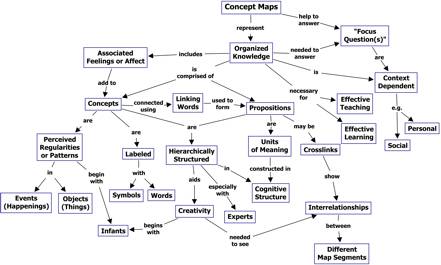Introduction
Concept maps are graphical tools for organizing and representing knowledge.
Concept is defined as a perceived regularity in events or objects, or records of events or objects, designated by a label.
Propositions are statements about some object or event in the universe, either naturally occurring or constructed. Propositions contain two or more concepts connected using linking words or phrases to form a meaningful statement.
Figure 1 shows an example of a concept map that describes the structure of concept maps and illustrates the above characteristics.

Figure 1. A concept map showing the key features of concept maps. Concept maps tend to be read progressing from the top downward.
Another important characteristic of concept maps is the inclusion of cross-links.
The fundamental idea in Ausubel's cognitive psychology is that learning takes place by the assimilation of new concepts and propositions into existing concept and propositional frameworks held by the learner. this knowledge structure as held by a learner is also referred to as the individual's cognitive structure.
Psychological foundations of Concept maps
The question sometimes arises as to the origin of our first concepts.
This early learning of concepts is primarily a discovery learning process, where the individual discerns patterns or regularities in events or objects and recognizes these as the same regularities labeled by older persons with words or symbols.
After age 3, new concept and propositional learning is mediated heavily by language, and takes place primarily by a reception learning process where new meanings are obtained by asking questions and getting clarification of relationships between old concepts and propositions and new concepts and propositions. This acquisition is mediated in a very important way when concrete experiences or props are available; hence the importance of "hands-on" activity for science learning with young children, but this is also true with learners of any age and in any subject matter domain.
In addition to the distinction between the discovery learning process, where the attributes of concepts are identified autonomously by the learner, and the reception learning process, where attributes of concepts are described using language and transmitted to the learner, Ausubel made the very important distinction between rote learning and meaningful learning.
No comments:
Post a Comment